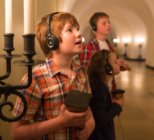Whether the ‘place’ is somewhere people pass daily, visit frequently, or make a once-in-a-lifetime pilgrimage to, the principles of placemaking have been flung wide open by the possibilities of digital technology and a 21st century demographic that craves more from the visitor experience.
Leading this shift are millennials. While the term technically describes anyone from a 19-year-old university student to young parents in their thirties, and is frequently used as a catch-all label for the ‘youth market’, millennials are a heterogeneous lot. With the right insight into this key demographic, heritage professionals can leverage digital technologies and lift their placemaking plans into the 21st century – and beyond.
Here we take a look at some of the behavioural, social, and psychological characteristics of today’s younger visitors, while keeping in mind their main prevailing trait: diversity.
Place: a fluid term
Millennials look well beyond the castle walls for their heritage kicks. Famous streets, notorious beauty spots – even virtual worlds – can be a draw for an audience that values story over convention.
In our recent interview with National Trust Creative Director Ivo Dawnay, he noted that millennials are drawn to a place to see what it looks like, to learn about those who lived there, and to educate themselves about the era they represent. When the National Trust opened a pop-up experience at the 1960s iconic – but bleak – social housing building Balfron Tower, tickets sold like wildfire. Its visitors weren’t drawn by its beauty; instead, they were compelled by its brutalism. Still in the research phases, the European Time Machine Project will likewise allow users to explore how their street looked 500 years ago and browse the ‘social networks’ of the middle ages, through advanced AI and machine learning technology.
By exploring areas within a site that might have previously gone unnoticed, heritage organisations can capitalise on the ‘everyday’ nature of heritage for a 21st century audience.
Community and connection
Millennials are interested in celebrating heritage, but often on a hyper-local basis. Modern lives are fragmented and communities atomised: heritage can add value through digital placemaking that draws out feelings of belonging and togetherness.
Soho Stories, the project we worked on for the National Trust, was a resounding success, in part, because the app engaged a generation of Londoners who previously saw Soho as a spot to enjoy happy-hour cocktails before catching a play. Our app added the missing piece of the puzzle, while offering millennials a learning experience with meaning by showcasing the seedy history behind Soho’s modern streets.
Digital placemaking doesn’t have to be grand-scale: at its core it’s about connecting people with places. 21st century audiences crave sociogenic experiences – it’s up to heritage professionals to provide them.

Co-creation and personalisation
If there’s one thing that millennial visitors are not, it’s passive. Their version of culture involves remixing and sharing, and ‘hands off’ is a major turn off.
To engage younger audiences, heritage organisations should embrace principles of authorship and ownership in their placemaking plans. In technological terms, the potential is there – for VR to put visitors centre stage, and for AI to project unique visitor journeys . Personalisation can be as high-tech as measuring visitors’ emotions through heart rate and other biometrics to deliver an experience to match – like at Glade’s Museum of Feelings. But it can also be achieved on a smaller scale through personalised exhibit recommendations or customisable learning experiences: the City of London Visitor Trail app allows visitors to choose from five guided walking trails depending on their own personal areas of interest.
Manipulating space the millennial way
Using audience observations and insight to craft and transform a visitor experience is nothing new. Within one site, different visitors may feel compelled to take photos of a favourite exhibit, while others will walk on by the same place entirely nonplussed. Individualism – and finding their own path – is a key characteristic of the millennial mindset, meaning heritage experiences should aim to be flexible and fluid.
Millennials value freedom: Creating non-linear journeys can attract 21st century audiences It’s a mistake to assume that 21st century audiences like their heritage experiences fast and furious, however – motivated by mindfulness, the saunter is making a comeback. Millennials value freedom, and may wander and explore a site before returning to the areas that resonate the most. Heritage sites can attract by creating non-linear visitor journeys – and apps are a great way to allow visitors to explore a site at their own speed and direction.
Make it emotional: mementoes, meaning, and magic moments
Emotions are an essential part of the ‘millennial experience economy ’. To engage visitors emotionally, heritage sites must first examine what they want visitors to feel. Joy? Fear? Amazement? Last year, Pokémon Go taught us that – for millennials at least – nostalgia is a powerful motivator. To capitalise on visitors’ emotions, ensure that their feelings are directly and logically linked not only to your site, but to your placemaking activities. The makers behind the 9/11 memorial app for example, took care to ensure a sense of sombre contemplation pervaded every aspect of the museum’s spaces, exhibitions, virtual tours and app – as well as the memorial itself.
Millennials like to collect things – and not just Pokémon. When currency is social, capital is earned by acquiring and displaying memories, whether it be an Instagram post, tweet, or status update. Providing visitors with site-appropriate options for capturing and sharing – selfies at Auschwitz are clearly a terrible idea – will encourage millennials to spread the word. Could a portrait generator or costume overlay work within your app? The dressing-up box and selfie-sharing function was a much talked-about feature in our app for the Jewish Museum London.
Simplicity, authenticity, provenance
Many mistakenly think a placemaking experience must be complex to engage millennials. Rich, emotional, three-dimensional; all are essential for a successful app. But so is simplicity.
21st century audiences are intrigued by smart cities, but equally attracted to the interplay between technology and the natural world. In Canada, the Rainy Day Shakespeare Project does just that: during a drizzle or a downstorm the sidewalks reveal Shakespeare quotes as a
way of using the natural elements to draw people away from Netflix and encourage free-form exploration of the city’s streets.
More than anything else, millennials desire authenticity. They want to learn, but all the better if it’s for a social purpose and has the relatability factor. Fame and infamy, glitz and mundanity: as long as a compelling story is engagingly told, all are equally interesting in the eyes of the millennial visitor.
Joining the dots and connecting the layers
Millennials – they’re a complex bunch. Immersed in digital, with a respect for nature; living in a fast-paced world and enjoying a saunter in their downtime. While technology provides the medium, the message is increasingly vintage – particularly if the popularity of the Nokia 3310 and resurgence of old-school craft beers are anything to go by.
Armed with this insight, heritage professionals should adopt a layered, multi-sensory approach to their digital placemaking – making use of available technology to enhance rather than mask a site’s natural identity. Doing so will ensure heritage sites can attract new audiences without alienating existing ones.











